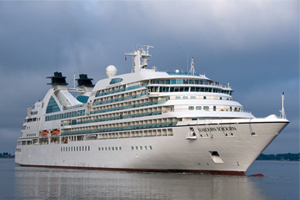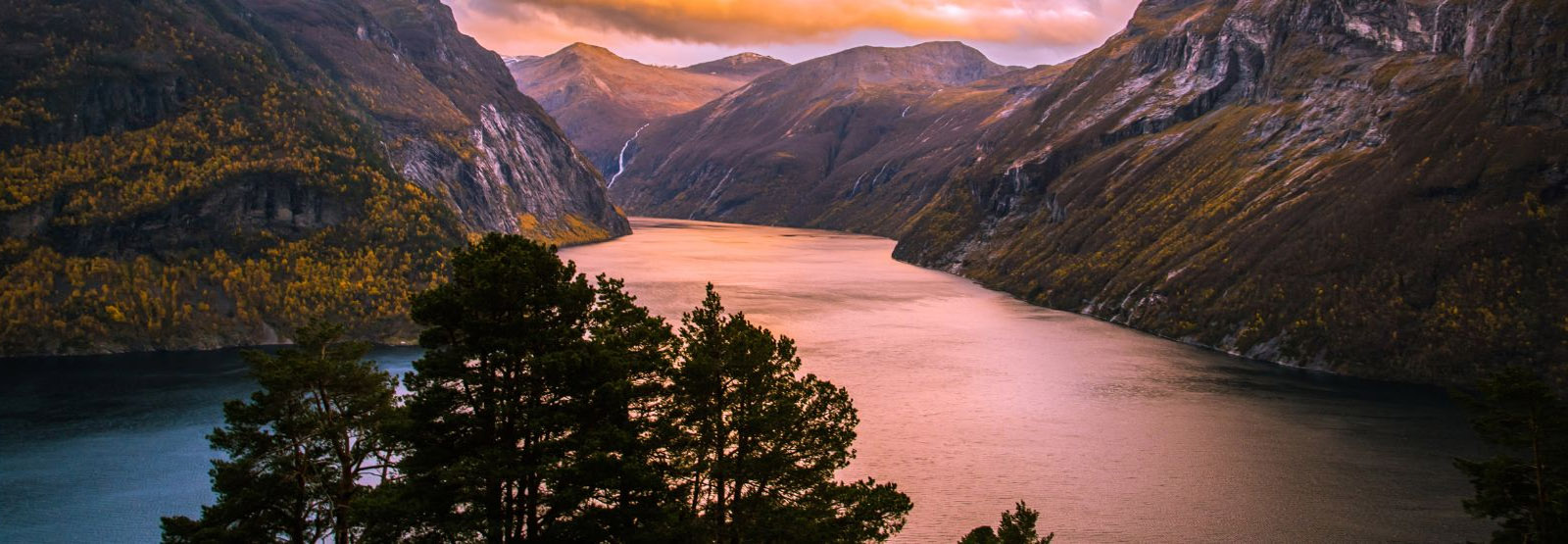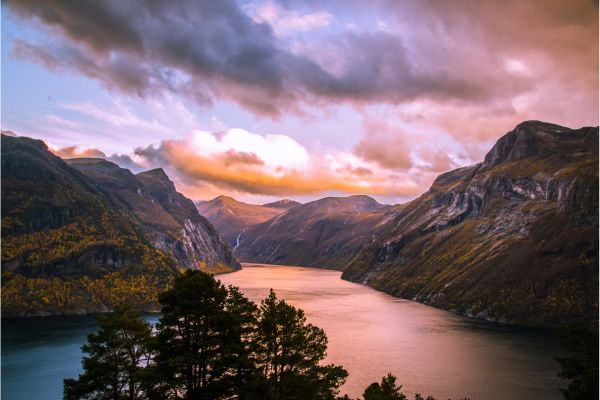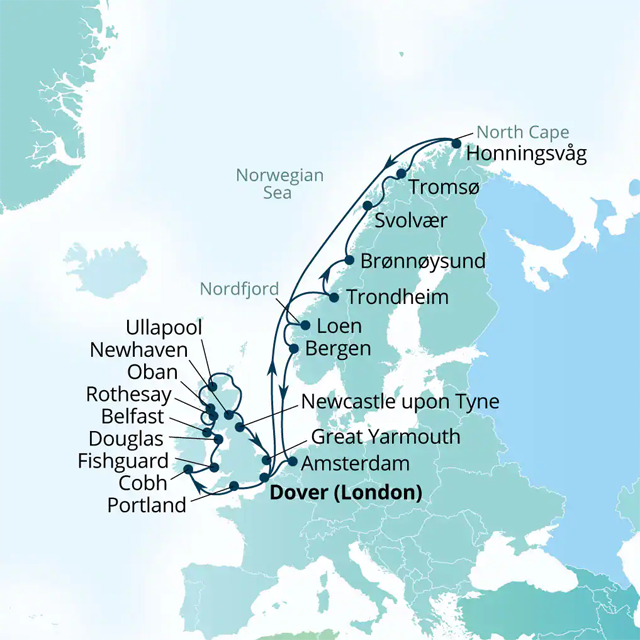DATES / RATES
Rates are listed per person
|
| Start Date | End Date | From EUR | From USD |
|---|
| May 31, 2025 | Jun 28, 2025 | 14,411 |
16,319 |
Rates are listed per person
|
| Start Date | End Date | From EUR | From USD |
|---|
| May 31, 2025 | Jun 28, 2025 | 14,411 |
16,319 |
ITINERARY
Day
0 : Dover (London), England, UK
Approaching
the coast, ships are greeted by the ethereal White Cliffs of Dover.
This iconic strip of milky-white land serves as England's welcoming
beacon, its stark beauty becoming more apparent as you draw closer. The
coastline unfurls like a grand tapestry, its white chalk cliffs
streaked with black flint, rising majestically 350 feet straight from
the sea's embrace.
The
echoes of ancient times resonate from every corner of Dover.
Archaeological treasures hint at the presence of human life during the
Stone Age, painting a vivid picture of the region's rich history.
However, it was the Romans who first recorded Dover's significance,
drawn by its strategic location just 21 miles from the French mainland.
Dover is home to remarkable Roman remnants, including the tallest
Roman-built lighthouse still standing in Britain, as well as the only
preserved Roman wall mural outside Italy.
Day 1 : Portland,
England, United Kingdom
Portland Island and the resort town of Weymouth are connected by a
5-mile (8 km) long neck of white sand known as Chesil Beach. Renowned
as the finest example of a barrier-type beach in Europe, Chesil Beach
was formed 10,000 years ago as glaciers receded and sea levels rose.
The rugged coastline of Dorset and the many attractions in the area are
what make Weymouth such a popular vacation destination. The Old Harbour
of Weymouth is an excellent Georgian-style harbor and one of the
prettiest in Europe. It bustles with activity from large catamarans,
fishing boats and yachts. Weymouth Sea Life Adventure Park displays
over 1,000 incredible sea creatures including sea turtles, crabs,
octopuses and sharks. The nearby Abbotsbury Sub-Tropical Gardens is an
impressive walled garden set in 20 acres (8 hectares) of woodland.
Portland Island offers stunning views across the Chesil Beach, Portland
Harbour, Fleet Lagoon and Weymouth. The little egret, once a rare bird
in Britain, is now regularly seen along these shores.
Day 2
: Days At Sea
Day 3 : Cobh (Cork), Ireland
Ireland’s
second-largest city, Cork takes belligerent pride in its history of
rebellion. It was founded in the 4th century by St. Finbarr, for whom
its first cathedral is named. Hardly less sacred to its citizens is the
Cork City Gaol, where its rebel heroes often resided. Visit the
Crawford Art Gallery for its collection of native Irish painters, and
Blarney Castle for a look at feudal history. Further afield, nearby
Cobh, formerly known as Queenstown, has an Emigration Centre tracing
the history of the great Irish diaspora.
Day
4 : Fishguard, Wales, United Kingdom
Fishguard’s
name in Welsh is Abergwaun, meaning the mouth of the River Gwaun. The
English name comes from an Old Norse word for a fish trap, and indeed
the community has profited from catching and drying herring for
centuries. It has remained remarkably unchanged physically over the
years. The waterfront has a traditional feel like many others in
Pembrokeshire. At first glance, nothing would indicate that this is the
site of the last invasion of Britain by a foreign power. But a
bicentenary stone recalls the day in 1797 when 1400 French
revolutionary troops landed here, only to be routed by the local folk,
including a heroic woman shoemaker named Jemima Nicholas, who rounded
up more than a dozen dismayed invaders while armed with a pitchfork. A
large tapestry depicting the struggle is on display in the Fishguard
Town Hall. The surrounding South Wales countryside is dotted with
medieval castles, some impressive, such as Pembroke and Picton Castles,
and others little more than scenically sited ruins. Cardigan also has a
notable garden called Dyffryn Fernant, and St. David’s boasts
an impressive early cathedral and a Bishop’s Palace.
Prehistoric Pembrokeshire is represented by the Pentre Ifan Burial
Chamber, a massive dolmen with an intact 15-ton capstone made of the
same type of rock that formed the inner sanctum of Stonehenge.
Day
5 : Douglas, Isle of Man, United Kingdom
The
town of Douglas is the center of the Isle of Man’s business,
shipping, transport, shopping, and entertainment. It derives its name
from the early Celtic word Duboglassio, meaning ‘black
river.’ Located in the Irish Sea, equidistant from
England, Scotland and Ireland, the Isle of Man is a self-governing
possession of the British Crown and is not part of the United Kingdom,
the Commonwealth, or an Overseas Territory, but instead holds
a semiautonomous status. It is home to the world's oldest continuous
parliament, known as the Tynwald Court.
The Isle of Man is a melting pot of character and taste, blessed with
an extensive coastline, stunning natural landscapes and unspoiled
beaches. It is home to numerous nature reserves, parks, historic stone
churches, castles and an abundance of diverse museums, including ones
dedicated to aviation, military, motorcycle, railway, folk, and
nautical exhibits. At the House of Manannan Museum visitors are guided
through interactive displays focusing on the island’s Celtic
and Viking past.
Day
6 : Belfast, Northern Ireland, United Kingdom
Belfast
is Northern Ireland’s fun-loving and cosmopolitan capital.
Its seat of government is Stormont Castle, a beautiful baronial
mansion. There is something of interest here for everyone: Victorian
architecture, a glittering waterfront, modern art, and over 90 Irish
pubs. The Giant's Ring, a 5,000-year- old stone
‘henge’ shows occupation here since the Bronze Age.
The magnificent copper dome of Belfast City Hall dominates the city
centre. Belfast is also the site of the memorial statue for R.M.S
Titanic, because it was here that the ship was built in 1909. Mixing
the traditional with the ultra-modern, the Titanic Belfast Museum
commemorates the fate of Titanic in its architecture. Shaped like the
great prow of the ocean liner, the museum’s exhibits tell the
story of the ill-fated vessel.
Some additional icons of the city include the 113’ (34 m)
Albert Memorial clock tower, the 12th century Belfast Castle, and the
twin spires of St. Peter's Cathedral. Discover art galleries, the Opera
house, fountains, botanical gardens, and a zoo in this dynamic city.
Day
7 : Rothesay, Isle of Bute, Scotland, United Kingdom
Rothesay,
standing along the Firth of Clyde, presents the visitor with a
combination of illustrious gardens and grand architecture. The
magnificent ruins of Rothesay Castle, which date from the 13th century,
are what most people visualize when they think of a medieval castle.
With a drawbridge, encircling moat, immense circular curtain wall and
tall stone towers, Rothesay is unique in Scotland for its circular
plan. The ruins of St Blane's Chapel, a 6th century monastery, sit atop
a hill with views over the Sound of Bute. For true elegance, visit the
country estate of Mount Stuart House with its colonnaded Marble Hall
and extraordinary Marble Chapel. Built in the late 1870’s in
the Gothic Revivalist style, it was constructed of reddish-brown stone
and houses a library of 25,000 books.
The Ardencraig Gardens, sitting atop Canada Hill, feature a walled
garden and exotic aviary. Ascog Hall Fernery, located on the grounds of
a baronial-style house from 1844, is a beautiful garden with the oldest
ferns in Britain.
Day 8 : Oban, Scotland, United Kingdom
Oban
is a small town on the west coast of Scotland. The site began as a
small fishing outpost and has been occupied as such for literally
thousands of years. Rural in its roots, the modern-day village of Oban
grew around the famed whisky distillery founded in 1794. Renowned for
its 14-year-old malt whisky, the Oban distillery has become a tourist
attraction, drawing many visitors to the area.
The quiet, rural feel of Oban is responsible for the abundance of
wildlife within the town boundaries. Here grey seals can be spotted
swimming in the harbor or resting along the shore. A wide variety of
land and seabirds are found throughout the area. On occasion dolphins
and river otters also visit. A beautiful balance exists between this
small town and the natural environment surrounding it, where the sounds
of nature mingle with the melody of the streets.
Day 9
: Ullapool, Scotland, United Kingdom
The
picturesque fishing town of Ullapool nestles on the shores of Loch
Broom, in the Highlands. Its location is one of the more pristine
natural environments in Britain. A diverse choice of walks in the area
includes mountains, rocky coasts, through forests and into deep gorges.
Dominating the landscape is the monolithic peak of 2,000’
(610 m) Stac Pollaidh. Nearby Corrieshalloch Gorge with its
150’ (46 m) Falls of Measach and the Inverpolly Nature
Reserve allow you to experience the natural beauty of the Highlands.
The geology of the area is highlighted by Knockan Crag National Nature
Reserve and the fascinating Inchnadamph Bone Caves. Formed by water
penetrating soft limestone, the caves contained 1,000 reindeer bones
dating back as far as 47,000 years. Beside them were found the bones of
four human beings, dating back 4,500 years.
Ullapool owns a reputation as a center for music, the arts and
performance. Explore the Ullapool Museum and the Leckmelm Shrubbery
& Arboretum.
Day 10 : Days At Sea
Day 11 : Newhaven (Edinburgh), UK
Newhaven,
about two miles north of the Edinburgh city center on the Firth of
Forth, is an historic harbor from which to visit Scotland’s
stately capital. Once an important fishing and shipbuilding community,
Newhaven is a conservation area with unique vernacular architecture
using a forestair to access a house’s first floor living
area, above a ground floor traditionally used for storing nets. The
town’s Victoria Primary School is the oldest operating
primary school in the United Kingdom. Edinburgh is perennially listed
among the most attractive and interesting cities in Europe. Its
patrician skyline bristles with steeples and spires between the Castle
Rock and Carlton Hill. Both the Old Town and New Town are inscribed by
UNESCO as World Heritage Sites. The city’s seven hills guard
an immensely rich heritage of architectural and historic buildings,
districts and streets to delight visitors. Edinburgh Castle, Holyrood
Palace, the Royal Mile and the Princes Street Gardens area are
world-renowned. The noble Scottish National Parliament, City Chambers,
Law Courts and Scottish National Gallery are equally prestigious
sights. A university city, Edinburgh nurtures a vibrant arts and
cultural community, a spirited nightlife and a burgeoning culinary
scene. A year-round agenda of celebrated festivals add further appeal
for visitors.
Day
12 : Newcastle upon Tyne, England, United Kingdom
Newcastle
upon Tyne, clinging to the north bank of the River Tyne, grew around
the Roman settlement Pons Aelius and was named after the castle built
here in 1080 by William the Conqueror's eldest son, Robert Curthose.
The port developed in the 16th century, quickly becoming one of the
world's largest shipbuilding centers. Newcastle harbors a spirited mix
of heritage and urban sophistication.
Among its ultra-modern structures, is the beautiful refined curve of
the Gateshead Millennium suspension bridge, one of seven major bridges
that cross The Tyne. The modern reflective, spherical-profile of the
Sage Gateshead Concert Hall contrasts greatly with the distinguished
vertical columns of the traditional-style Theatre Royal, located in
Grainger Town, the historic center of Newcastle.
Other city highlights include the Great Northern Museum, The Castle
Keep tower-fortification built in 1172, and stunning St Nicholas and
St. Mary’s Cathedrals, built in 1091 and 1844. For nature
lovers there is the serene landscape of Jesmond Dene Park with its
verdant woodland, rock crags, tranquil pools and plunging waterfalls.
Day
13 : Great Yarmouth, England, United Kingdom
The
seaside resort town of Great Yarmouth, situated in the Norfolk region
of England, was originally the site of the Roman fort of Gariannonum.
Located at the mouth of the River Yare, it became a wealthy trading
center of considerable importance. It rose to prominence as a major
center for tourism when the railway reached it in 1844. Big skies,
sweeping beaches, windswept marshes, meandering inland waterways and
quaint flint houses combine to great effect in the Great Yarmouth area.
The market place, operating since the 13th century, is one of the
largest in England. Museums, theaters, the Sea Life Centre,
and the Norman-era Minster Church of St Nicholas, built in 1101, are
amongst the many attractions. An historical highlight is the Lord
Nelson monument, commemorating the achievements of Admiral Horatio
Nelson. High atop the 144 ft (44 m) column stands the statue of
Britannia, proudly standing on a globe inscribed with the motto from
Nelson’s coat of arms and holding a trident and olive branch.
Day 14 : Dover (London), England, UK
Approaching
the coast, ships are greeted by the ethereal White Cliffs of Dover.
This iconic strip of milky-white land serves as England's welcoming
beacon, its stark beauty becoming more apparent as you draw closer. The
coastline unfurls like a grand tapestry, its white chalk cliffs
streaked with black flint, rising majestically 350 feet straight from
the sea's embrace.
The
echoes of ancient times resonate from every corner of Dover.
Archaeological treasures hint at the presence of human life during the
Stone Age, painting a vivid picture of the region's rich history.
However, it was the Romans who first recorded Dover's significance,
drawn by its strategic location just 21 miles from the French mainland.
Dover is home to remarkable Roman remnants, including the tallest
Roman-built lighthouse still standing in Britain, as well as the only
preserved Roman wall mural outside Italy.
Day 15-16 : Days At Sea
Day 17 : Trondheim, Norway
Founded
in 997, Trondheim is one of Norway's oldest cities, situated midway
between southern and northern Norway. Dominated by the massive Nidaros
Cathedral, Trondheim is often referred to as the Royal City.
Traditionally, the kings of Norway have been crowned in the cathedral,
which is considered a National Shrine. Straddling both sides of the
River Nid, on Trondheimfjord, much of the town was rebuilt after a
disastrous fire in 1681 destroyed the majority of its original wooden
structures. Some of the oldest buildings, dating to the 1700s, have
survived along the river, while the wide streets of the city center
boast picturesque and brightly painted houses.
Day 18 : Bronnoysund,
Norway
A coastal city, Brønnøysund’s origin
dates back to its 13th century Viking heritage. In the intervening
centuries, it has been settled by immigrants from southern Norway and
Sweden, and its local Swedish-like dialect still carries echoes of this
past.
Brønnøysund sits on a narrow peninsula from the
mainland, is surrounded by waterways dotted with a maze of small scenic
islands. In this fairytale setting, picturesque, colorful houses are
set amidst thick lush greenery, turquoise blue water and shallow bays.
Towering above the town like a giant troll’s hat is the
massive granitic monolith of Torghatten Mountain. Here can be found one
of the great natural curiosities of the area, a 520’ (160 m)
hole piercing completely through the center of the mountain. The Viking
sagas surmised that it was the impact of a warrior horseman’s
arrow that created the wound. However, it was actually formed during
the last Ice Age by erosion from ice and water.
Day 19 : Svolvaer
(Lofoten), Norway
Huddled together in what appears to be a wall of solid rock, the
Lofotens are actually several islands. Their scenery, revealed when the
ice disappeared from the last Ice Age, is held to be among the most
dramatic in Norway. Svolvaer, located on the island of Austvaagoey,
received town status in 1996, and is the Lofotens' most important city
with about 4,500 residents. Dominating the town is the mountain peak
called Svolvaergeita, a beacon for climbers. Fishermen flock here when
the Norwegian Arctic cod enters the Vestfjord to spawn. Artists prize
the picturesque setting and extraordinary light conditions.
Day 20 : Tromso, Norway
Tromsø is the largest city in northern Norway and the ninth
most populous municipality in the country. It surprises visitors with
its sophisticated art scene, its contrasting modern and historical
architecture, international cuisine, multicultural events, and
festivals throughout the year.
Situated 200 miles north of the Arctic Circle, Tromsø is
within the land of the midnight sun during summer months and the
elusive northern lights in winter. However, thanks to the warming
effect of the Gulf Stream, the sea doesn’t freeze here in
winter, and there is no permafrost in the vicinity. Tromsø
is noticeably milder than other towns at the same latitudes in other
parts of the world.
Tromsø is also ‘The City of Explorers’
and has seen a number of expeditions set off from its shores to the
probe the polar realm. Both Roald Amundsen and Fridtjof Nansen
frequently recruited men in the city. Nowadays home to the Norwegian
Polar Institute, Tromsø continues a tradition of being one
of the key centers in explorations of the Arctic.
Day 21 : Honningsvag,
Norway
The perpendicular cliffs of Nordkapp, or the North Cape, mark the very
top of the European continent. This ultimate destination has long drawn
adventurous royalty including Oscar II, King of Norway and Sweden, who
visited in 1873, and followed by the King of Siam in 1907. The North
Cape is located on the island of Mageroey, a name derived from a word
that means 'meager.' While the landscape may have a lunar appearance,
it is not really so isolated. Just 21 miles away, the main town,
Honningsvåg, has some 4,000 inhabitants. In summer that
number swells when the Sami people and their reindeer settle on the
outskirts of town.
Day 21 : Scenic Cruising
North Cape
The looming cliffs of Norway’s North Cape rise directly from
the sea 1007 ft/307m to a plateau as flat as a table. This impressive
headland has been selected to represent the northernmost point of
Europe, even though it is technically located on an island,
Magerøya, connected to the mainland by a bridge. At
71° 10’ 20” N latitude, it is just 1,306
mi/2012 km from the North Pole. At this point, the Norwegian Sea, which
is part of the Atlantic Ocean, meets the Barents Sea, part of the
Arctic Ocean. Further north, the mountainous archipelagoes of Franz
Josef Land and Svalbard are the last lands before the Polar Ice Pack.
The Midnight Sun does not dip below the horizon here at any time
between May 14 and July 31 each year. Sheer and formidable, the North
Cape pays its role to the hilt, emphatically declaring itself the end
of Europe’s landmass.
Day 22-23 : Days At Sea
Day 24 : Loen (Olden), Norway
The small village of Olden is located deep in the
Nordfjord, cradled in a lush valley among snowcapped peaks. It has
welcomed visitors arriving by ship since the end of the 19th century,
as attested by the venerable Hotel Alexandria dating from 1884. There
are some very old farms around Olden, including some believed to
predate the Christian era here. Less than four miles away, the village
of Loen is nestled at the base of Mt. Hoven, where a newly opened
Skylift cable car can carry visitors from sea level to the mountaintop
at 1,011 meters in about five minutes. There, they will enjoy panoramic
views of the surrounding peaks and glaciers, and the fjords, farms and
villages below. A strung cable Via Ferrata invites ambitious climbers
to clip on and ascend the mountain on foot. The village is the popular
gateway to the sprawling Jostedalsbreen National Park, with its system
of glaciers feeding waterfalls including the Ramnefjellsfossen, whose
three free-falling cascades tumble nearly 2,700 feet, making it the
world’s third-highest waterfall. Mt. Skala is another popular
attraction, boasting twin peaks of over 7,000 feet in altitude.
Day 24 : Scenic Cruising
Nordfjord
Cruise Norway’s sixth-longest fjord, which arises from the
mighty Jostedalsbreen Glacier, Europe’s largest, high in the
mountains and empties into the sea at
Husevågøy island south of the Stadlandet
Peninsula. The fjord is 66 miles/106 km long, with six main branches.
It is surrounded by snow-capped peaks, some of which are capable of
offering year-round skiing on their highest slopes. There are a number
of fishing communities along the fjord which date from pre-Viking days,
including Stryn, Gloppen, Eid, Utvik, Olden and Loen. Enjoy the passing
panorama of shining water, steep mountainsides and tiny villages
glowing in the endless sun of Norway’s summer.
Day 25 : Bergen, Norway
Stunningly beautiful Bergen is the ideal combination of nature, culture
and exciting urban life, and is also the gateway to Norway’s
fjords. Since King Olav Kyrre founded the city in 1070, Bergen has
attracted people from all over the world. The city's history has been
marked by numerous great fires, and what remains of the Bryggen, its
old inner harbor, is a UNESCO World Heritage Site and the colorful
setting for one of Norway’s most popular postcard views.
Bergen is a cultural melting pot, with concerts, international
festivals and museums of all kinds. The renowned Hanseatic Museum and
Gamlehaugen Mansion, the residence of the Norwegian Royal Family, are
two of the many highlights. Den Nationale Scene Theater is one of the
oldest in Norway, while beautiful Christ Church Cathedral, built by
King Olav Kyrre in 1066, has been the site of numerous royal
coronations and burials. The Bergenhus fortress, built in 1240, is
situated at the harbor entrance and is one of the oldest and
best-preserved stone fortifications in Norway.
Day 26 : Days At Sea
Day 27 : Amsterdam, The Netherlands
The delightfully attractive city of Amsterdam is home to
many of the world's great art treasures, and is a major center of the
glamorous diamond trade as well. Unique architectural styles of the
past blend with superb modern structures, and the web of curved and
straight canals makes the city as easy to traverse by water as by land.
The hospitality of the local people has been remarked upon by
generations of travelers, and the Dutch's respect for and tolerance of
the beliefs of others has attracted refugees from around the world for
centuries.
Day
28 : Dover (London), England, UK
Approaching
the coast, ships are greeted by the ethereal White Cliffs of Dover.
This iconic strip of milky-white land serves as England's welcoming
beacon, its stark beauty becoming more apparent as you draw closer. The
coastline unfurls like a grand tapestry, its white chalk cliffs
streaked with black flint, rising majestically 350 feet straight from
the sea's embrace.
The
echoes of ancient times resonate from every corner of Dover.
Archaeological treasures hint at the presence of human life during the
Stone Age, painting a vivid picture of the region's rich history.
However, it was the Romans who first recorded Dover's significance,
drawn by its strategic location just 21 miles from the French mainland.
Dover is home to remarkable Roman remnants, including the tallest
Roman-built lighthouse still standing in Britain, as well as the only
preserved Roman wall mural outside Italy.
Seabourn Sojourn (Luxury Expedition, 458-guests)
Seabourn Sojourn enchants her guests with an array of public areas scaled to encourage a relaxed sociability. One of the most unusual features of Seabourn Sojourn and her sisters is Seabourn Square, an ingenious "living room" that replaces the traditional cruise ship lobby with a welcoming lounge filled with easy chairs, sofas and cocktail tables; making it more inviting and relaxing on a small ship cruise. An enclave in its center houses knowledgeable concierges discreetly seated at individual desks.
 (Click image to view Ship details)
(Click image to view Ship details)
WHAT'S INCLUDED
Please Call Us to find out what is included in the fare







